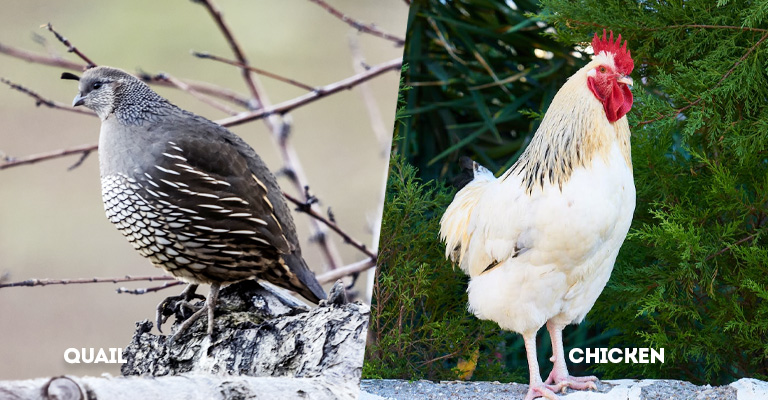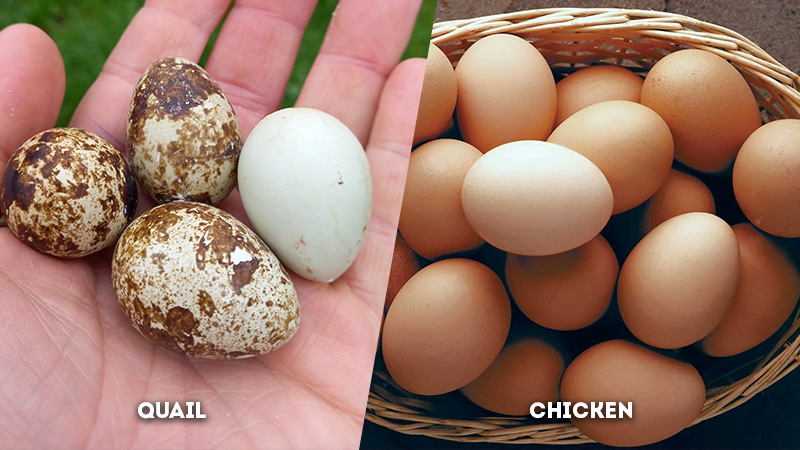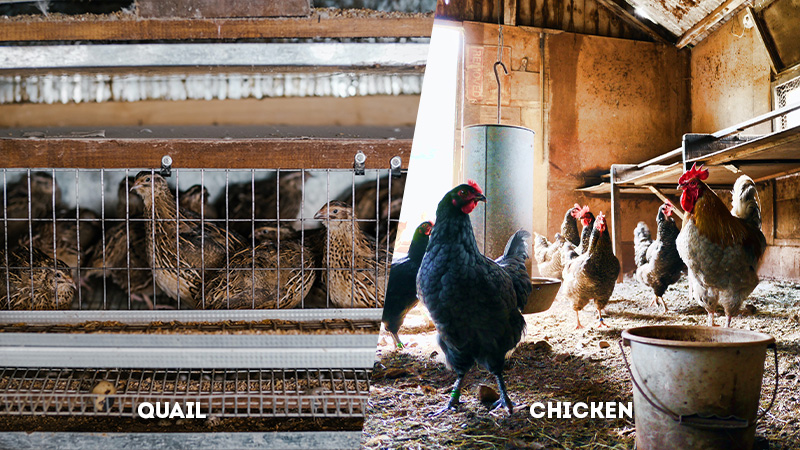In the realm of culinary choices, the comparison between quail and chicken brings forth a fascinating exploration of flavors, nutrition, and cultural significance.
While both quail and chicken belong to the poultry family, their distinctive attributes offer a diverse array of options for consumption, culinary experimentation, and even farming practices.
From the nuances of taste and texture to considerations of nutritional content and environmental impact, each bird presents a unique set of characteristics that cater to different preferences, dietary needs, and cultural contexts.
This exploration delves into the multifaceted nature of quail and chicken, shedding light on their roles in gastronomy, agriculture, and human culture.

Key Differences Between Quail and Chicken
Quails and chickens are both types of birds, but they have several key differences in terms of size, behavior, habitat, and uses.
Here are some of the main differences between quails and chickens:
Size
- Quail: Quail are notably smaller birds, characterized by their compact size. They have a delicate build, with petite bodies and relatively short legs.
Their small size makes them easier to manage in terms of housing and care. Quail are well-suited for smaller spaces and are often raised in more confined environments. - Chicken: In contrast, chickens are larger and more substantial in size. They have a well-defined body structure, with longer legs and a more robust frame. Their larger size requires more space for proper movement and comfort.
Due to their size, chickens need larger coop setups and more extensive roaming areas when raised in backyard or free-range settings.
Nutritional Content
- Quail: Quail meat stands out for its remarkable nutritional content. It boasts higher iron and protein levels compared to chicken meat.
This makes quail an excellent option for individuals seeking to boost their iron intake or looking for a protein-rich diet. The higher iron content is particularly beneficial for those with iron-deficiency anemia. - Chicken: While chicken may not match quail in terms of iron content, it remains a valuable source of lean protein. Chicken is a staple in many diets due to its versatile cooking options and widespread availability.
Its protein content supports muscle development and overall health. Although chicken may not have as much iron as quail, it still provides a substantial amount and offers a broader range of culinary possibilities.
Taste and Texture
- Quail: Quail meat is renowned for its delicate flavor and unique texture. The taste of quail is often described as richer and more pronounced than chicken. The meat is lean and tender, offering a delightful melt-in-the-mouth experience.
Quail’s distinct flavor makes it a favorite in gourmet dishes and upscale restaurants. Its small size also allows for more creative culinary presentations. - Chicken: Chicken, being a widely consumed poultry, offers a familiar and versatile taste. Its flavor is more subtle compared to quail, making it a canvas for various seasonings and preparations. Chicken’s texture can range from tender to firm, depending on the cooking method and cut.
The versatility of chicken allows it to adapt to diverse cuisines and cooking styles, making it a staple ingredient in global culinary traditions.
Egg Production

- Quail: Quails are notable for their early egg-laying capabilities. They mature quickly and begin laying eggs at an earlier age than chickens.
This early onset of egg production is advantageous for those seeking a quicker return on investment in a farming setup.
Quail eggs are smaller in size but are considered a delicacy in some cultures due to their distinct flavor and potential health benefits. - Chicken: Chickens have a longer maturation period before they start laying eggs. While they take more time to reach egg-laying age, chicken eggs are larger and are more commonly consumed globally.
The larger size of chicken eggs makes them more suitable for various culinary applications, from baking to cooking.
Availability
- Quail: Quail is often considered more of a specialty item and might not be as readily available in all regions.
Finding quail meat or eggs might require visiting specialty markets or restaurants that cater to niche culinary interests. This limited availability can sometimes make quail a more sought-after and premium ingredient. - Chicken: Chicken, on the other hand, enjoys widespread availability. It is a staple protein source in many cultures and is readily found in supermarkets, butcher shops, and restaurants worldwide.
The ubiquity of chicken makes it an accessible option for various dietary needs and culinary preferences.
Culinary Uses
- Quail: Quail’s unique flavor and smaller size lend themselves well to elegant and gourmet culinary creations. Quail dishes often focus on highlighting the meat’s delicate taste and tender texture.
They are commonly roasted, grilled, or pan-seared whole, presenting an impressive visual appeal. Quail eggs are prized for their decorative role in appetizers and canapés, adding a touch of sophistication to dishes. - Chicken: Chicken’s versatility makes it a staple ingredient in a wide range of dishes. It can be used in everything from hearty stews and comforting soups to quick stir-fries and elaborate roasts.
Chicken’s neutral flavor acts as a blank canvas, readily absorbing various spices, herbs, and sauces. Different cuts offer different textures, allowing for diverse cooking techniques and flavor profiles.
Cost
- Quail: Due to its smaller size and less common status, quail can be relatively more expensive compared to chicken.
The costs of raising, processing, and sourcing quail contribute to its premium price. Quail’s price point often positions it as a choice for special occasions or when seeking a gourmet dining experience. - Chicken: Chicken’s affordability is one of its most significant advantages. It is widely produced and consumed, leading to economies of scale that keep its cost relatively low.
Chicken’s accessibility and cost-effectiveness make it a practical choice for regular meals and larger gatherings.
Sustainability
- Quail: Quail farming might offer certain sustainability benefits due to the birds’ smaller size and faster growth.
They require less feed, space, and resources compared to chickens. Quail farming could potentially be more environmentally friendly, especially in contexts where resource conservation is a concern. - Chicken: Chicken production practices vary widely, affecting its overall sustainability. Conventional large-scale chicken farming can have environmental drawbacks, such as water and land usage and emissions. However, more sustainable practices, such as organic and free-range farming, can mitigate these issues.
Cooking Techniques
- Quail: Quail’s smaller size and delicate meat call for careful cooking techniques. Roasting, grilling, and pan-searing are common methods to preserve its tenderness and enhance its flavor. Quail’s size also makes it suitable for skewers or as an ingredient in complex dishes.
- Chicken: Chicken’s versatility shines through its adaptable cooking methods. It can be roasted, grilled, fried, sautéed, boiled, or even prepared in slow cookers or pressure cookers.
The variety of cooking techniques ensures that chicken can suit a wide range of culinary styles and preferences.
Dietary Benefits
- Quail: Quail’s higher iron and protein content offers specific dietary benefits. Its iron content can be beneficial for individuals with iron-deficiency anemia or increased iron requirements.
The relatively higher protein content contributes to a sense of fullness, which can aid in portion control and weight management. - Chicken: Chicken’s lean protein content makes it an excellent choice for muscle development and overall health.
Its lower fat content and high-quality protein contribute to various dietary goals, from weight loss to muscle recovery. Chicken is a source of essential amino acids that support various bodily functions.
Fillingness
- Quail: Quail meat’s higher protein content can lead to a greater feeling of fullness even when consumed in smaller portions.
This characteristic makes quail an appealing option for those looking to manage their portion sizes while still feeling satisfied after a meal. - Chicken: While chicken may not have the same protein density as quail, its satiating effect is still significant. The combination of protein and other nutrients in chicken contributes to a sense of fullness, supporting balanced and satisfying meals.
Egg Size
- Quail: Quail eggs are notably smaller than chicken eggs. Their diminutive size makes them an interesting addition to appetizers, salads, and garnishes.
Their delicate appearance can enhance the visual appeal of dishes, and their unique taste sets them apart from larger eggs. - Chicken: Chicken eggs are larger and more commonly used in various culinary applications. Their size makes them suitable for baking, frying, scrambling, and other cooking methods. Chicken eggs are a standard ingredient in many recipes, both sweet and savory.
Cultural Acceptance
- Quail: The consumption of quail is often more prevalent in specific cultures or gourmet settings. Some cultures highly regard quail meat and eggs, while others might be less familiar with its culinary uses. Quail may be considered a delicacy or a specialty ingredient in certain regions.
- Chicken: Chicken enjoys widespread cultural acceptance and is a staple protein source in many cuisines around the world. Its versatility and familiarity have contributed to its popularity and integration into various traditional dishes.
Farming Space

- Quail: Quail’s small size makes it suitable for compact farming spaces. Quail farming can be pursued even in limited areas, making it an option for urban or backyard farming setups. This smaller space requirement can be advantageous in environments with space constraints.
- Chicken: Chickens require more space due to their larger size. Adequate space for movement, nesting, and foraging is essential for their well-being. Raising chickens might require more extensive coops and outdoor areas, which can limit their feasibility in certain locations.
Caring Complexity
- Quail: Quail are relatively easier to manage compared to chickens. Their small size means they require less feed and resources, and their behaviors are generally simpler to understand. Their quick maturation and early egg-laying also contribute to simplified care routines.
- Chicken: Chickens can be more complex to care for due to their larger size, varied behaviors, and longer maturation periods. Their diverse needs, from feeding and housing to disease prevention, can make chicken farming more intricate and demanding.
Breeding
- Quail: Quails have a faster maturation rate and reproduction cycle compared to chickens. This makes quail breeding a potentially quicker process for achieving desired quantities of meat or eggs. Their ability to reproduce at a younger age contributes to their efficient breeding and production.
- Chicken: Chickens have a slower reproduction cycle compared to quails. It takes longer for chickens to mature and start laying eggs. This difference in breeding timelines can impact the rate of meat and egg production for chickens.
Market Demand
- Quail: Market demand for quail meat and eggs can vary regionally and is often niche-oriented. Quail products might have a specific audience, such as gourmet restaurants or cultures where quail is more commonly consumed. This can influence their pricing and availability.
- Chicken: Chicken products have a consistently high market demand globally. The familiarity and versatility of chicken make it a staple in various cuisines and food industries. Its broad market demand contributes to its affordability and widespread availability.
Environmental Impact
- Quail: Quail farming, due to the smaller size and potentially lower resource requirements, might have a comparatively lower environmental impact. The reduced feed and space needs of quails can contribute to more sustainable farming practices.
- Chicken: The environmental impact of chicken farming can vary depending on the production methods employed.
Conventional large-scale chicken farming can have significant resource consumption, waste production, and emissions. Sustainable practices, such as organic or free-range farming, can mitigate some of these impacts.
Culinary Exploration
- Quail: Quail offers an opportunity for culinary exploration and experimentation. Its unique flavor and smaller size invite creativity in the kitchen.
Chefs and home cooks can develop innovative recipes that showcase quail’s delicate taste and presentational possibilities. - Chicken: Chicken’s culinary exploration lies in its adaptability to various flavors, cuisines, and cooking techniques. While it might not offer the same novelty as quail, its versatility encourages cooks to continuously discover new ways to prepare and enjoy it.
Dietary Diversity
- Quail: Incorporating quail into the diet adds a layer of dietary diversity due to its distinct nutritional content and taste. Quail’s higher iron content and unique flavor profile offer an alternative source of nutrients and culinary experiences.
- Chicken: Chicken’s prevalence and varied cuts contribute to dietary diversity by offering options for lean protein intake. Its neutral taste allows for a wide range of flavor combinations, accommodating different dietary preferences and needs.
Quail Vs Chicken: Comparison Table
| Aspect | Quail | Chicken |
|---|---|---|
| Size | Smaller, compact size | Larger, more substantial |
| Nutritional Content | Higher iron and protein content | Slightly lower iron, but still rich in protein |
| Taste and Texture | Delicate, unique flavor and texture | Familiar taste and texture |
| Egg Production | Mature faster, lay eggs earlier | Slower maturation, eggs are larger |
| Availability | Often considered a specialty | Widely available and consumed |
| Culinary Uses | Less common in global cuisine | Versatile ingredient with many recipes |
| Cost | Can be more expensive due to rarity | Generally more affordable |
| Sustainability | Potentially lower resource footprint | Depends on farming practices |
| Cooking Techniques | May require specific preparation methods | Familiar cooking methods apply |
| Dietary Benefits | Higher iron could benefit iron-deficient | Offers lean protein source |
| Fillingness | Higher protein content may offer better satiety | Still provides a satisfying meal |
| Egg Size | Smaller eggs | Larger eggs, suitable for various uses |
| Cultural Acceptance | Less commonly consumed in many cultures | Ubiquitous in various cuisines |
| Farming Space | Requires less space due to size | Larger space requirement |
| Caring Complexity | Easier to manage due to size and behavior | More complex care and housing needed |
| Breeding | Faster maturation and reproduction | Slower reproduction cycle |
| Market Demand | Niche market demand may vary regionally | High demand due to global consumption |
| Environmental Impact | Potential for lower environmental impact | Depends on farming and sourcing practices |
| Culinary Exploration | Offers a unique culinary experience | Familiarity in various dishes |
| Dietary Diversity | Adds variety to protein sources | Mainstream protein option |
Frequently Asked Questions
While crossbreeding between quail and chicken is theoretically possible due to their shared family (Phasianidae), it’s not a common practice. These two species have significant genetic differences, making successful crossbreeding challenging. Moreover, the specific traits desired from each species might not always translate well in a hybrid.
Quail eggs are often considered a delicacy in some cultures and are believed to offer certain health benefits. They are known for their high protein content and potential to reduce allergy symptoms due to lower allergenic proteins compared to chicken eggs. However, individual reactions to foods vary, and more research is needed to substantiate these claims.
Quail farming typically requires less space and resources due to the smaller size of quails. They can be raised in smaller enclosures, making them suitable for urban or backyard farming. Chickens, being larger, generally need more space for movement, and their housing and outdoor requirements are more extensive.
Yes, the taste and texture of both quail and chicken can be influenced by their diet. Just like with other animals, the flavors of their meat and eggs can be subtly altered by the foods they consume. For instance, free-range chickens might have a different flavor profile compared to conventionally raised chickens due to differences in diet and exercise.
Yes, both quail and chicken have cultural and religious significance in various societies. In some cultures, quail is considered a symbol of sacrifice and humility. In certain religions, such as Islam and Judaism, there are dietary laws that dictate the acceptability of consuming chicken and other meats. Cultural beliefs often influence how these birds are prepared, consumed, and regarded.
To Recap
The comparison between quail and chicken reveals a tapestry of choices that intertwine taste, health, culture, and sustainability. These two poultry options, each with its own set of attributes, offer individuals a diverse range of culinary experiences and dietary benefits.
Whether it’s the delicate flavor of quail, the versatile nature of chicken, or the ethical considerations of sustainable farming, both birds play pivotal roles in our kitchens and diets.
As consumers, understanding the nuances of quail and chicken empowers us to make informed decisions that align with our values, preferences, and the ever-evolving tapestry of global food culture.